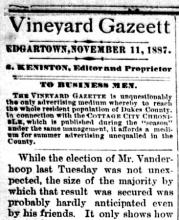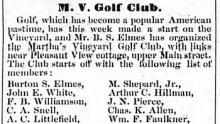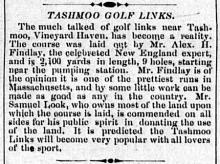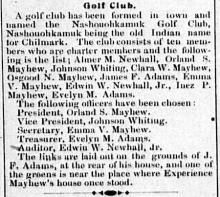Golf courses dominated the discussion following a lecture on the role of environmental mediation in resolving public policy and site disputes last Tuesday evening. Held at the Wakeman Center in Vineyard Haven, the lecture was sponsored by The Nature Conservancy, The Wampanoag Tribe of Aquinnah and the Martha’s Vineyard Commission.
Dr. Scott McCreary of the California-based environmental mediation firm CONCUR, spoke to a small audience about the importance of environmental mediation as a dispute-solving strategy, discussed the outcomes of two case studies that he worked on, and explained how the approaches used in these studies can be applied to the Vineyard.
Mr. McCreary said that the process of environmental mediation helps simplify disputes complicated by many players with separate opinions. Environmental mediators demystify technical complexity in situations where “everybody has their own scientists,” he said. They find creative ways to protect areas of the environment that slip through or overlap government regulatory categories of air, sea and land, he said.
At the end of his discussion, Mr. McCreary sparked a discussion by asking four questions — “Do you think the techniques of environmental mediation are applicable to the Vineyard?” “What are the issues?” “Who is credible to serve as a convener?” and “If you think these ideas have promise, what are the next steps to be taken on the Island?”
Yes, answered the audience to Mr. McCreary’s first question. Golf courses, they said to the second. With three separate proposals filed on the Island — two in Edgartown and one in Oak Bluffs — golf courses have been on many people’s minds. The third and fourth questions, however, left the audience stumped.
“I’ve thought a lot about this. I think the golf course issue is a very important one environmentally, socially and visually for the Island,” said Dick Johnson, director of the Sheriff’s Meadow Foundation. “I’m frustrated that it’s not being considered anyplace, what is best for the Island. I’m racking my mind and I don’t see who the respected convener would be who could pull all the parties together.”
Maybe the Island has to invent one, Mr. McCreary said. Any group can act as the convener, a garden club, the League of Women Voters. With respect to the next steps to be taken, perhaps the question needs to be stated. One way of framing the problem is, “Where should we site another golf course on Martha’s Vineyard?” he said. Another is, “How can we provide a reasonable rate of return for this development and at the same time create a sustainable environment that is consistent with the surrounding land use?”
“Does the Martha’s Vineyard Commission look like a credible auspices?” asked Mr. McCreary. “On the one hand, they do have an Islandwide scope. They have a lot of discretion. They don’t always weigh in on each land use decision but they do have land use regulating authority. Are they really neutral? Can they be neutral?”
“I would think that if they have regulatory authority then they’re bound by their regulations,” said one woman.
Philippe Jordi, grant planner for the Wampanoag Tribe, said there are times both on town and on regional levels when the Martha’s Vineyard Commission has an opportunity to step back and allow the mediation to happen on its own, make the stakeholders come to some kind of negotiation themselves.
“That’s a way of using their weight to kind of force something to the table,” he said. “I’m just wondering whether this is an approach that people know about. I think it’s a question of bringing that awareness to people who want to take a leading role in the situation.”
It makes sense to deal with the issue on a regional and not a piecemeal basis, agreed participants.
“None of those golf developers individually want three golf courses on Martha’s Vineyard, from an economic reality if nothing else they don’t want the competition,” said Dan Small. “None of those three developers want the litigation. None have an interest in mediating their golf courses because they want them to go forward. But all three of them have an interest in mediating all three golf courses as a land use planning issue if you explain it to them and convince them of it.”
Margie Hayden said that there is a mediation program on the Island — Martha’s Vineyard Mediation. She was frustrated that people don’t call on it.
The discussion turned to blue ribbon committees, which Mr. McCreary described as taking a bunch of experts, locking them up and telling them to write a report.
“The problem with that approach is that the policy makers are excluded as well as the other stakeholders, who may need that information,” Mr. McCreary said. “The policy makers aren’t there to witness the deliberations and therefore can’t appreciate the rationale for what the experts recommend. So I don’t like the blue ribbon panel as much as the joint fact-finding model.”
“I think that is exactly right because as you may remember, the commission formed a group to discuss the transportation problem on Martha’s Vineyard,” said West Tisbury resident Kate Warner. “And those people worked and worked and worked and they hired on a planner to make recommendations. And the planner came up with recommendations and the towns didn’t take on any of them.”
Miss Warner asked whether it is realistic to think that the golf course developers will sit down and negotiate with the rest of the parties involved.
“Lots of times these developers have nothing to do with this place,” she said. “When they come to the table, what do they care about the quality of life here? They don’t.”
“Well, they care about predictability. They care about a decision-making process that looks rational, that they can count on,” said Mr. McCreary. “They care about having a decent enough relationship with the local decision makers that they can go forward.”









Comments